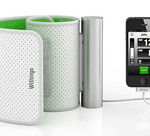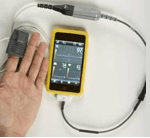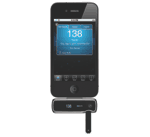by Katie Matlack
The iPhone and iPad are changing the world of medical devices as we know it. Thanks to their familiar interface, Web connectivity, and powerful processing capabilities, with the right app and plug-in these iOS devices can work as super smart medical devices that make sharing as easy as the push of a touchscreen button.
Your patients can now access increasingly high-quality medical devices, making it easy to be more actively engaged in their own health and provide you with information needed for better patient care. And home and rural caregivers can benefit from the portability and versatility of iPad and iPhone based devices. Below are three examples of powerful iOS medical devices I’ve found that already exist.
1) The Withings Blood Pressure Monitor
 French company Withings developed this blood pressure monitor that features an app and a cuff that fits most average-sized people. Accurate data on blood pressure can help patients monitor hypertension, reducing the risk of serious consequences to their heart, brain and kidney. The Withings monitor can even work with an iPod Touch, and runs at $129. Patients can use the device to share their data with you.
French company Withings developed this blood pressure monitor that features an app and a cuff that fits most average-sized people. Accurate data on blood pressure can help patients monitor hypertension, reducing the risk of serious consequences to their heart, brain and kidney. The Withings monitor can even work with an iPod Touch, and runs at $129. Patients can use the device to share their data with you.
2) ECEM Pulse Oximeter
 This device isn’t yet available to the masses, but given its utility, I imagine it will be soon. It features a small clip that attaches to your fingertip. The clip beams a light through your fingertip to a receiver on the opposite side; the amount of light received is used to determine how much oxygen is saturated in your blood. Developed by the Electrical and Computer Engineering in Medicine research group together with the Pediatric Anesthesia Research Team at the University of British Columbia, it was originally created to help make anesthesia care safer in the developing world, but can also be useful to patients with heart or lung problems such as emphysema.
This device isn’t yet available to the masses, but given its utility, I imagine it will be soon. It features a small clip that attaches to your fingertip. The clip beams a light through your fingertip to a receiver on the opposite side; the amount of light received is used to determine how much oxygen is saturated in your blood. Developed by the Electrical and Computer Engineering in Medicine research group together with the Pediatric Anesthesia Research Team at the University of British Columbia, it was originally created to help make anesthesia care safer in the developing world, but can also be useful to patients with heart or lung problems such as emphysema.
3) iBGStar Glucose Meter
 From Sanofi-Aventis comes this glucose meter app and plug-in. The glucose meter is a well-known device to anyone with diabetes. Today, diabetics test blood sugar with needles and a clunky kit; the iBGStar offers a small add-on to the iPhone that’s said to give better, more accurate results. Plus, getting data on the iPhone means it can be shared easily with medical personnel, and patients can also get reminders on their iPhone when it’s time for another check.
From Sanofi-Aventis comes this glucose meter app and plug-in. The glucose meter is a well-known device to anyone with diabetes. Today, diabetics test blood sugar with needles and a clunky kit; the iBGStar offers a small add-on to the iPhone that’s said to give better, more accurate results. Plus, getting data on the iPhone means it can be shared easily with medical personnel, and patients can also get reminders on their iPhone when it’s time for another check.
For more discussion of the benefits of these iPhone and iPad based devices, plus commentary on two more devices not discussed here and commentary from an expert on medical devices, visit the Software Advice blog for the original article.
Katie Matlack is the Medical Software Analyst at Software Advice, a free online resource.


